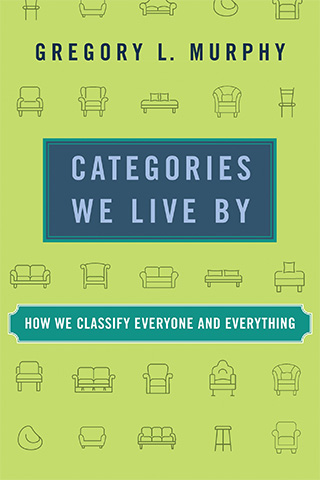How We Sort the World: Gregory Murphy on the Psychology of Categories

The minute we are born — sometimes even before — we are categorized. From there, classifications dog our every step: to school, work, the doctor’s office, and even the grave.
Despite the vast diversity and individuality in every life, we seek patterns, organization, and control. Or, as cognitive psychologist Gregory Murphy puts it: “We put an awful lot of effort into trying to figure out and convince others of just what kind of person someone is, what kind of action something was, and even what kind of object something is.”

In his new book “Categories We Live By,” Murphy, a professor emeritus at New York University who has spent a career studying concepts and categories, considers the categories we create to manage life’s sprawling diversity. Analyzing everything from bureaucracy’s innumerable categorizations to the minutiae of language, his book reveals how these categories are imposed on us and how that imposition affects our everyday lives.
In the interview that follows, Murphy discusses his lifelong interest in studying concepts and categories — “the glue that holds our mental world together,” as he’s described them — the impact of his research on his worldview, and the complex relationship between language and categorization across cultures.
What got you interested in studying concepts and categories, and how did this eventually lead to your new book?
I started studying categories in my first year of graduate school. The psychology of categories was fairly new and an exciting area then, because of the important discoveries by Eleanor Rosch and her students (some reviewed in the book). It was clear that the traditional way of studying how people learn categories was no longer appropriate, and we had to develop new techniques and ask new questions. So, it was a great time to be in the field.
But, as happens in many scientific fields, the work began to get increasingly technical and specialized. By this century, much of the work relied on mathematical models and computer simulations in order to test different theories. This is a normal and generally useful progression, but it meant that the average person couldn’t read the work or benefit from the field’s discoveries.
We often feel that once we determine the thing’s category, then all questions will be answered about it.
As I became a “senior figure” (ahem) in the field, I began to think that to some degree we’ve lost the forest for the trees, so I wanted to write about some of the important things we have learned about categories over the past 50 years, many of which are interesting or useful (and some both). Not all of this comes from psychological research; there have also been important contributions from philosophy, linguistics (especially semantics), and anthropology. I also wanted to get beyond theoretical investigations and talk about a lot of concrete examples, from the life-changing to the trivial. I learned a lot from doing research into some of these examples and thought others would find these cases interesting as well.
I want to get back to some of those examples. But first, how do you think your work has changed the way you view the world?
I think it has made me more skeptical of arguments about identities, of people and all kinds of things. We put an awful lot of effort into trying to figure out and convince others of just what kind of person someone is, what kind of action something was, and even what kind of object something is. We often feel that once we determine the thing’s category, then all questions will be answered about it: The person is qualified or unqualified; it’s the right thing to do or the wrong thing; the object must be made out of wood. But division into categories is often arbitrary — not completely, but in some respects. And every category is a simplification to some degree; it throws away information about the thing. If you call me an academic, that is no doubt true, but that doesn’t include a lot of other information about me, nor do I correspond exactly to your stereotype of an academic. (OK, I actually do, but a lot of academics don’t.)
There are a number of different ways to make categories, and they don’t always agree with one another. At some point, we have to make a principled decision about what the category is and why that is the best way to think about it, because the world isn’t pre-divided into nice categories that we simply have to notice.
That’s not to say that disputes over categorization aren’t important. They may be necessary, especially in rule-making contexts like the law or in organizations. But you have to take the entire process with a grain of salt and recognize the limits of what the category can tell you.
You suggest that any human culture that had language must have also had categories. How do words and their meanings influence the way we categorize and understand the world around us?
The relationship between language and categories is pretty complex. One thing to keep in mind is that every content word essentially specifies a category, of all the things that can be called by that word. So, a verb like jump specifies a category of actions that we would describe using that verb. A noun like cat specifies a category of the animals we would call “cat.” However, word meanings are often very complex and extended. They can include very different things.
An obvious example is homonyms, when two different and unrelated words happen to have the same name. From the point of view of the child learning a language, these are confusing, and one of the joys of parenthood is being forced to explain why the flying bat is called the same thing as a baseball bat, why we hear through ears but eat ears of corn, how a calf can refer both to a baby cow and to the muscles on the bottom of the leg, and so on. Children soon figure out that “that’s just the way it is” and have to go along with the crazy word meanings that adults have given to them. But from the perspective of the Whorfian hypothesis — which proposes that the language we use influences and shapes our thought processes and worldview — all such cases are troubling. I don’t think that English speakers believe that baseball bats are in any way similar to the mammal, even though they have the same name. There are limits on how much language can shape our thoughts.
Of course, most words are not homonyms, but many very common words have a lot of different, though related, meanings. So, the word church can be used to refer to a religious organization but also to a building (“The church burned down.”). Surely organizations and buildings aren’t the same kind of thing. So, language is an imperfect clue to what categories we have. Research comparing similar words of different languages confirms this: The categories picked out by different languages can be very different, even when people’s categories are quite similar.
Language is an imperfect clue to what categories we have.
Still, we have to admit that word meanings can help or hinder the learning about categories. If you’re a new skier, hearing people use words like popcorn or powder to describe different kinds of snow may help you learn what different kinds of snow there are and how they affect your skiing. But it seems pretty clear that this vocabulary developed historically in response to the categories that skiers had already figured out. The words didn’t come first, and then people learned about snow later. If there is a category that is important to us, society tends to find a label to refer to it.
How much do categories differ across languages and cultures? Do you believe certain languages inherently foster different categorization systems?
It’s hard to give a specific answer to this. In some respects, the categories of different cultures are surprisingly similar. In other respects, they’re (not-so-surprisingly) different. In the basic, common categories of everyday life, different cultures seem to have pretty similar categories. The differences may be in more social and abstract categories. There’s actually a field of study — ethnobiology — that compares the categories of the natural world across cultures, and to some degree, people pick out the same categories, or at least the same kinds of categories even in very different cultures. Of course there are differences when parts of the natural world occur in one place but not in another. I don’t know the different kinds of birds of South Asia, and I would imagine that the people of South Asia don’t generally know the different American sparrows or wild mammals. That is not very surprising. However, when people in different parts of the world make categories of plants or animals, they tend to make about the same kinds of categories, often based on the biological genus: categories like oaks, sparrows, trout, or roses.
Anthropologists who have studied nonindustrial societies often find that their categories of plants and animals are pretty similar to ours at a middle level. The differences are often found in the more specific and more abstract categories. An abstract category like arthropods is something that scientists may find useful and that you could be taught in your biology class, but it’s not something that people who are directly in contact with animals find at all useful. Arthropods don’t look very similar, don’t do the same behaviors, aren’t all edible, and so on. Knowing about crabs is useful; knowing that crabs and millipedes are in the same category… not so much. Similarly, people often know about very specific categories only when they are actually used in agriculture, hunting, or for some specific purpose. If you raise corn, you will want to know which corn is good to plant, which is only good for animal fodder or is decorative, and so on. So, you’ll have categories of different kinds of corn to help distinguish them. If you don’t raise corn, then you’ll probably just see it all as corn.
So, for most natural categories, the effect of culture is in providing focus and expertise to develop more categories of the things you’re interested in. Occasionally, that focus may result in categories that are specifically designed for a single purpose, like edible fish that can be caught in the local rivers. This is not a “natural” category, and it wouldn’t be known to people who don’t fish or don’t live in the area, but it could be very useful to the subset of people who rely on fishing or engage in it as a hobby. We may all form categories like that in our mini-cultures of special interests and activities.
The second part of your book is organized around specific case studies exploring categories ranging from critical (medicine, race, mortality) to trivial (peanut butter, almond milk, parking regulations). We could probably dedicate separate discussions to each of those, but since it’s not feasible to cover any of them comprehensively here, can you share the broader insights these diverse case studies collectively offer about the nature of categories?
Theories of categories are useful only insofar as they tell us about real examples. If they can only be applied to artificial and simplified situations (as in many psychology experiments), they aren’t of much use. So, my goal was to show how the different aspects of categorization play out in real examples. Some of these are outright silly, such as whether a burrito is a sandwich, or the famous case of whether Pringles are potato chips. Others are extremely important to the people involved and to society as a whole, such as racial or legal categories.
What’s interesting to me is that the same issues arise for the trivial and serious categories, such as the difficulty of making a definition that works, beliefs that categories have essences, and problems of fuzzy boundaries. Sometimes the law steps in, to tell us just how much peanut something must have to be sold as peanut butter or exactly what criteria must be met for someone to be declared dead. But such rules still allow for unclear cases, and often people don’t know or don’t follow those rules in their everyday lives. So, there are at least two categories: the official one based on the law and the one that most people actually use.
Is there anything else you think our readers should know?
I had the idea early in my career that science might step in and tell us what the answers are, at least for some categories. However, many scientific categories have the same problems as our everyday categories do. The case of Pluto is one that many people know. During the debate over whether Pluto is a planet, it came to light that there was no definition of what a planet is. Oops! And I discovered, to my dismay (which I share in the book), that there is little agreement in biology over how to determine what a species is. The problem, I argue, is not in science or in our human institutions, but in the world, which is extraordinarily complex. There are many different valid ways of dividing up the entities in the world, and we have to figure out which ones are useful to us. That’s why understanding how and why we make categories is itself an important goal. The world doesn’t give us categories for free — we have to make them ourselves.
Gregory L. Murphy is Professor Emeritus of Psychology at New York University. He is the author of “The Big Book of Concepts” and “Categories We Live By.”



